Best DJ software 2025: Mixing applications to suit every genre, setup and budget
The top free and paid-for software for club, scratch or event DJs, for Mac, PC and mobile
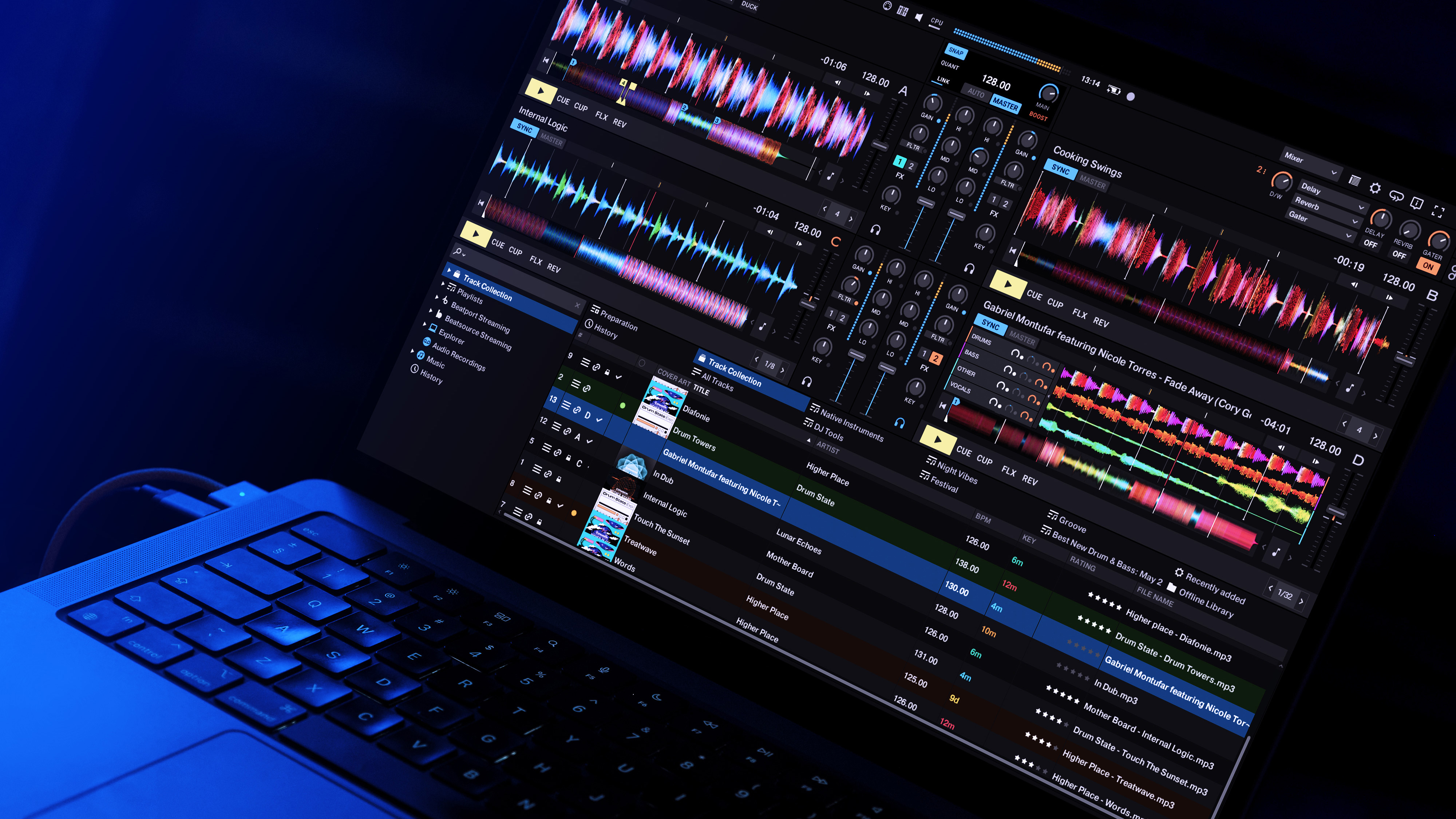
In the modern music age there’s no one single ‘correct’ way to be a DJ. Your DJ setup could involve vinyl turntables and a mixer, CDJs, DJ software and a controller, or just about anything that allows you to blend two or more tracks together. These approaches aren’t mutually exclusive either; it’s easier than ever to create a setup that lets you blend approaches and formats.
In terms of convenience and affordability though, using one of the best DJ software applications is undoubtedly the most accessible approach to DJing. Turntables, CDJs and mixers are expensive bits of gear whereas – assuming you already own a laptop – it’s possible to get started with basic digital DJing for free if you choose the right software.
Add a hardware controller and you've got a setup that feels great and will enable you to do anything that was possible using an old-school setup and a whole lot more.
Modern tech is only making digital DJing more convenient and flexible. The rise of streaming integration means that it's not essential to bring any actual music to your gigs at all – be it vinyl, CD or even a USB – although we'd still be wary of relying on an internet connection at all times.
What's more, the latest fashionable feature in the DJ world, AI stem separation, means its now possible to get creative with another artist's pre-mixed tracks on the fly.
Whether you want to show off with the latest tech, or just a simple tool to mix your favourite tracks at home, our guide has options that should please DJs of all styles, experience levels and budgets.
Best DJ software: MusicRadar’s Choice
Although there’s a lot we like about rekordbox from AlphaTheta (formerly Pioneer DJ), particularly when it comes to its track management and organisation tools, its weaker-than-most stem separation and expensive subscription model hold version 7 back from topping our list. While pro DJs will still likely find the investment worthwhile, hobbyist or occasional DJs will be better spending their money elsewhere.
In terms of all-round performance, Serato is the top performer. It’s been a titan of the digital DJ realm for years, and although it’s particularly favoured by scratch DJs, its versatile tool set will suit DJs of any persuasion. Our main criticism of Serato in 2024 is that its multitude of add ons and pricing models can be quite confusing. Although thankfully it can still be purchased outright, rather than being subscription-only.
For those sick of subscriptions and extra purchases, the recently revived Traktor is a very tempting option. While the software itself offers little that’s truly innovative or unique, its toolset is well-rounded and versatile enough for most home or simple pro setups. The fact that it can be purchased outright for a single, reasonable price is certainly its biggest asset.
Alternatively, Mixxx is completely free and open source, which is obviously appealing. The trade off for this, however, is that it lacks features like AI stem separation or integration of streaming services such as Beatport or Soundcloud – although it’s likely the community around it will work on these things in the future.
Best DJ software and apps: Product guide
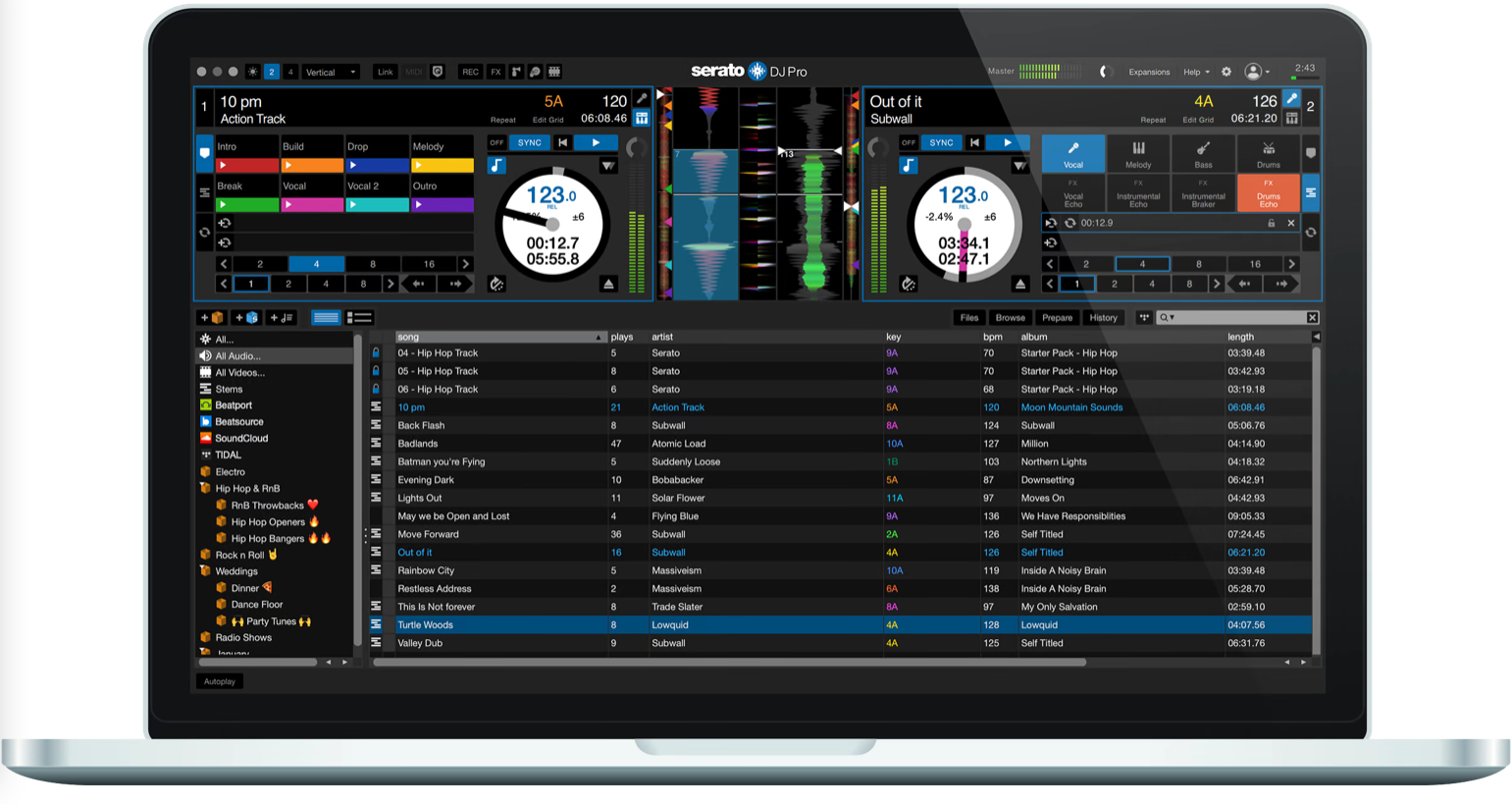
1. Serato DJ Pro
Our expert review:
Specifications
Reasons to buy
Reasons to avoid
Serato spearheaded the birth of digital vinyl systems back in the early ‘00s and has remained one of the major players in digital DJing ever since. Its various software applications have gone through a host of iterations and name changes over the years, but in recent times the range has been simplified around a single flagship app, Serato DJ Pro, and its free counterpart, Serato DJ Lite.
Although you’ll find Serato DJ users in all corners of the DJ realm, it’s most entrenched among scratch DJs and turntablists. The reason for this comes down, in part, to the company’s heritage, but also its more varied approach to controller compatibility. Serato itself doesn’t produce any hardware, meaning that – unlike Traktor or rekordbox, where all official controllers are produced by the same brand – Serato can be used with a broad range of officially endorsed gear from the likes of Rane, Denon, Numark, Pioneer DJ and more. This naturally results in a more diverse range of setup options, particularly for digital vinyl users.
Serato added stem separation and mixing at the start of 2023 and in-terms of quality remains up there with the best – isolated vocals can occasionally sound oddly dry, but it’s not something you’d really notice in a mix.
Although the base software offering is pretty simple at first glance, many advanced features like DVS support, remix effects and visual mixing control require an additional subscription or hardware unlock, so it’s not quite the ‘one price for all’ it might initially appear to be.
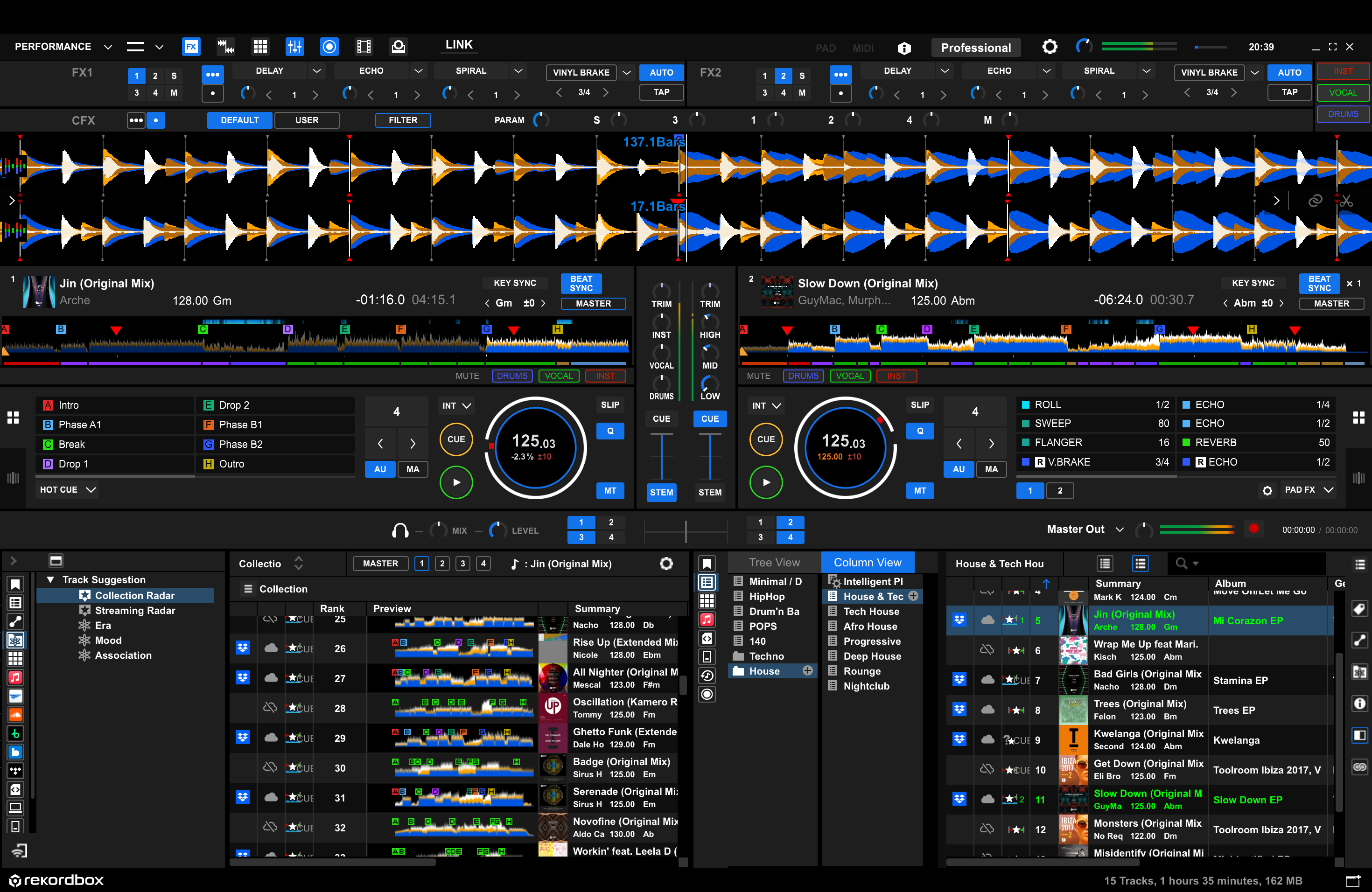
Specifications
Reasons to buy
Reasons to avoid
Rekordbox was formerly distributed under the Pioneer DJ name, but as of its version 7 update, it’s been rebranded under the AlphaTheta name – the umbrella brand that, confusingly, both owns and operates alongside Pioneer DJ.
For club DJs, rekordbox’s biggest appeal lies in how closely it mirrors the workflow of Pioneer DJ’s industry standard CDJs and the company’s growing range of all-in-one DJ systems. This means that not only are any mixing skills learned in rekordbox easily transferred to other Pioneer-focused setups, but the track library is easily shared across platforms – something enhanced by the cloud capabilities offered in some of rekordbox’s subscription tiers.
As such, rekordbox’s librarian functions have long been a significant selling point, and it’s here where many of version 7’s headline features appear. The software now offers a variety of ‘smart’ tools to aid with track organisation, these include automatic cue point assignment – similar to functionality offered by Mixed in Key – as well as improved ‘suggested track’ tools. In our initial tests, both elements have proved useful, if a touch hit-and-miss.
Another major enhancement has been improved CPU performance. Previous iterations could be sluggish on older machines, so this is very welcome. AlphaTheta has also tidied up the interface a little, which is most obvious in the preferences panel.
As is standard across the industry now, rekordbox offers stem separation and mixing tools. In terms of quality though, rekordbox’s stem functionality is outperformed by some of its key rivals though. We’d be surprised if we didn’t see a refresh in an update in the near future.
Our least liked aspect of rekordbox is its emphasis on subscription pricing. While the software can be downloaded for free and used in a basic form, to operate rekordbox with a controller and access its key features, users will need a subscription, which range from £/$21 to £/$30 per month.
Users can also make use of a ‘hardware unlock’ whereby using Pioneer or AlphaTheta hardware unlocks features otherwise requiring a subscription. However, with version 7, AlphaTheta controversially removed some older hardware devices from the unlock list, meaning that owners could no longer access the latest version of the software.
Read the full Pioneer DJ rekordbox DJ review (version 1)

3. Native Instruments Traktor Pro
Our expert review:
Specifications
Reasons to buy
Reasons to avoid
Having first launched in 2000, Traktor is one of the longest serving DJ applications on the market. During the latter half of the ‘10s, however, Native Instruments appeared to go somewhat cold on the DJ arm of its business. During that time the company changed ownership and merged with software brands Plugin Alliance and iZotope, and released little in the way of new DJ gear, beyond a few perfunctory Traktor updates.
Thankfully, 2024 has finally brought a new version of NI’s flagship DJ software, Traktor Pro 4. On the one hand, a lot of what Pro 4 has to offer is playing catch-up with its rivals rather than offering anything revolutionary. The software adds automatic stem separation and mixing – as opposed to the format-reliant Stems functionality of previous versions. It also introduces flexible beatgrids, the absence of which had previously made mixing non-electronic genres in Traktor next-to impossible.
The software also gains a neat and fun mini drum machine in the form of Pattern Player, which can be loaded with sounds from artists including Luke Slater and Rebekah. Both Pattern Player and the Ozone Maximiser were previously offered as part of NI’s Traktor Pro Plus subscription, now thankfully abandoned.
In fact, as dull as it sounds, Traktor Pro’s new pricing structure is its best feature. Where many rivals lean into subscriptions and add-ons, Traktor Pro is now a single, unified product available for a single – very reasonable – outright purchase price (or a cheaper upgrade from previous versions). It’s this that is likely to appeal most to a lot of users, although as a sad consequence of this streamlining, NI has also discontinued its free Traktor DJ counterpart.
While it holds its own against the big names, Traktor Pro feels reassuringly neat and self-contained, both in terms of its usability and cost.
Read the full Native Instruments Traktor Pro 4 review
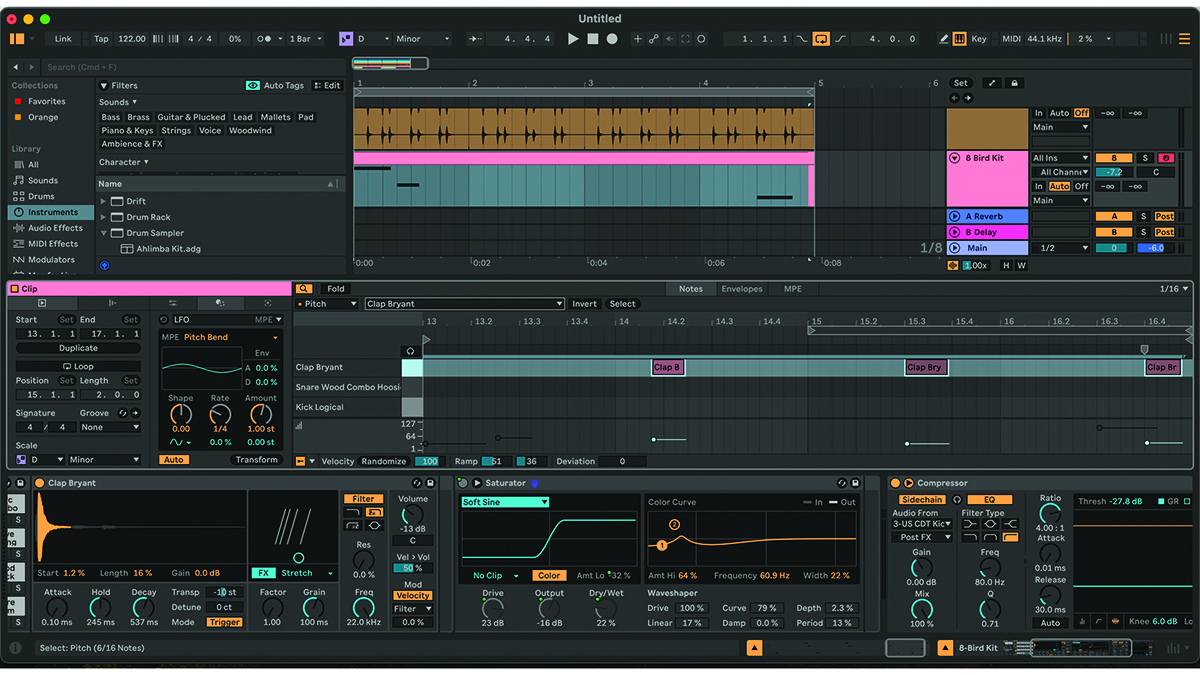
Specifications
Reasons to buy
Reasons to avoid
Ableton Live is something of an anomaly in this list, due to the fact that it’s not really a true DJ software application - or at least it wasn’t originally imagined as such. Still, while it may have been first envisioned as a loop-focused performance and production tool, in the years since its inception Live has become a favourite of DJs across the world.
Key to its popularity with DJs is the Session View - a brilliantly implemented and cleanly designed window for launching synced audio samples, MIDI clips and tracks. It’s this view, along with the intuitive way that Live handles retiming audio, that makes the DAW a fantastic tool for blurring the lines between DJing and live performance.
With the added bonus of a heap of built-in instruments and effects, the ability to host plugins and an intuitive MIDI learn function, Live makes an unbeatable one-stop-shop for electronic musicians. What's more, you can choose from any number of controllers that can work with it.
Ableton’s Link technology adds to its appeal as a performance tool. This is an open software tool that allows developers to add wireless sync to their applications. You can find Link as part of a host of DJing apps, iOS tools, DAWs and plugins, making it easier than ever to jam with multiple laptops or tablet devices.
Seeing as it’s not really a piece of specific DJ software, it’s a little unfair to compare Live’s specs directly with the rest of the market, but it is worth highlighting that the DAW lacks the stem separation tools found in most DJ apps (as well as some rival DAWs such as Logic Pro).
Read our full Ableton Live 12 Suite review
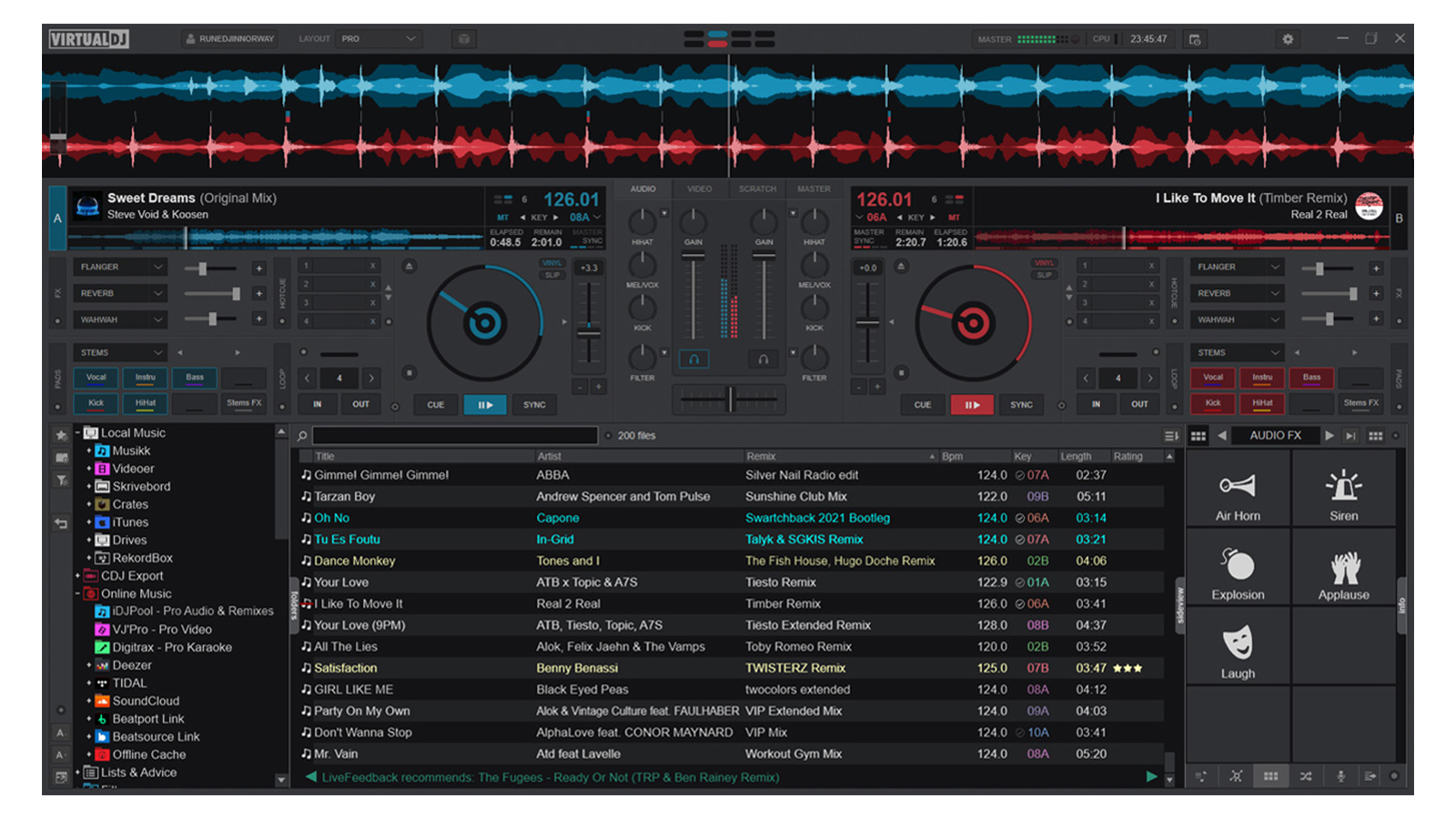
5. Atomix VirtualDJ Pro
Our expert review:
Specifications
Reasons to buy
Reasons to avoid
VirtualDJ claims to be the world’s ‘number one most popular DJ software’, which is likely due to the fact that it can be downloaded and used at home for free, in a limited but still very much functional capacity. This makes it a great option for beginners, as does the fact that its interface and workflow is generally quite user-friendly.
Even in this free format, VirtualDJ boasts some impressive features. Its interface is highly customisable and can be configured with anywhere between 2 and 99 decks (not that we’d recommend you attempt to blend 99 tracks at once).
VirtualDJ was one of the first applications to incorporate stem separation – DJing feature-of-the-moment – into its workflow. While the rest of the industry has now caught up with these capabilities, the software’s solid and slick stem functionality is still up there with the best. The latest iteration also adds overhauled software EQs.
The main restrictions on using the free version of VirtualDJ are that you’re not licensed to use it in any professional settings – ie. any paid DJ gigs, streams, etc – and that it can’t be used with any hardware such as controllers, analogue mixers or DVS systems.
It’s here that VirtualDJ jumps from an appealing bargain to a fairly pricey option. A Pro licence will set you back $299 or $19 per month as a subscription. It is possible to buy a controller-specific licence for cheaper than a full Pro one – starting at $49 – but these are only available for home use with certain entry-level controllers, and you’re locked into using a specific piece of hardware.
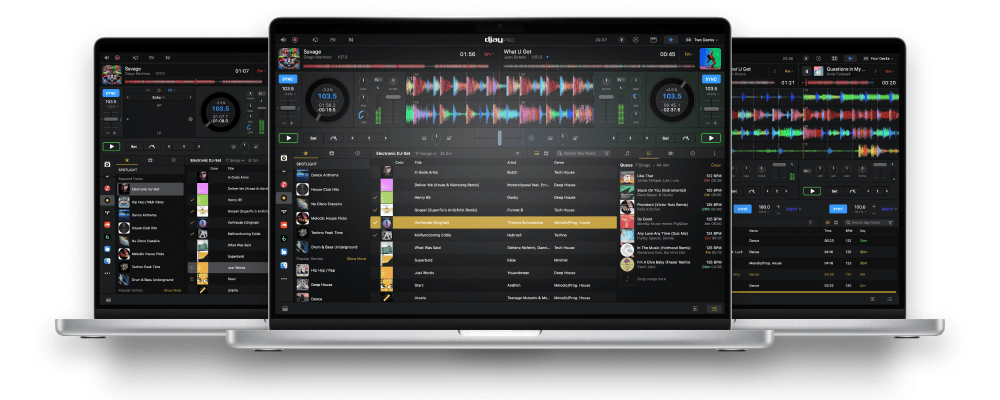
6. Algoriddim djay Pro
Our expert review:
Specifications
Reasons to buy
Reasons to avoid
One of the most appealing things about Algoriddim’s djay Pro is how well it works across Apple’s different platforms. Users can make use of a single app across Mac, iPhone, iPad and even on their Apple Watch or Vision Pro headset – the latter option letting users mix in VR with a set of virtual decks. djay Pro also offers Apple Music streaming integration in many, but not all, countries. There are versions available for Windows and Android too.
Along with VirtualDJ, djay Pro was one of the first applications to add AI-assisted stem separation into its workflow, in the form of its Neural Mix tech. The rest of the DJ sphere has now caught up on this now, and in some ways overtaken it – many DJ apps will split tracks into four separated stems, whereas Neural Mix splits into three, Beats, Instruments and Vocals. It’s still a powerful tool though.
Another appealing feature of djay Pro is that it offers DVS support not only on Mac, but iOS too, meaning you can hook a compatible scratch mixer up to your phone and away you go.
There’s not a ton of dedicated hardware designed for djay – although Reloop make a few officially-branded controllers – but algoriddim offers mappings for a lot of devices from major brands.
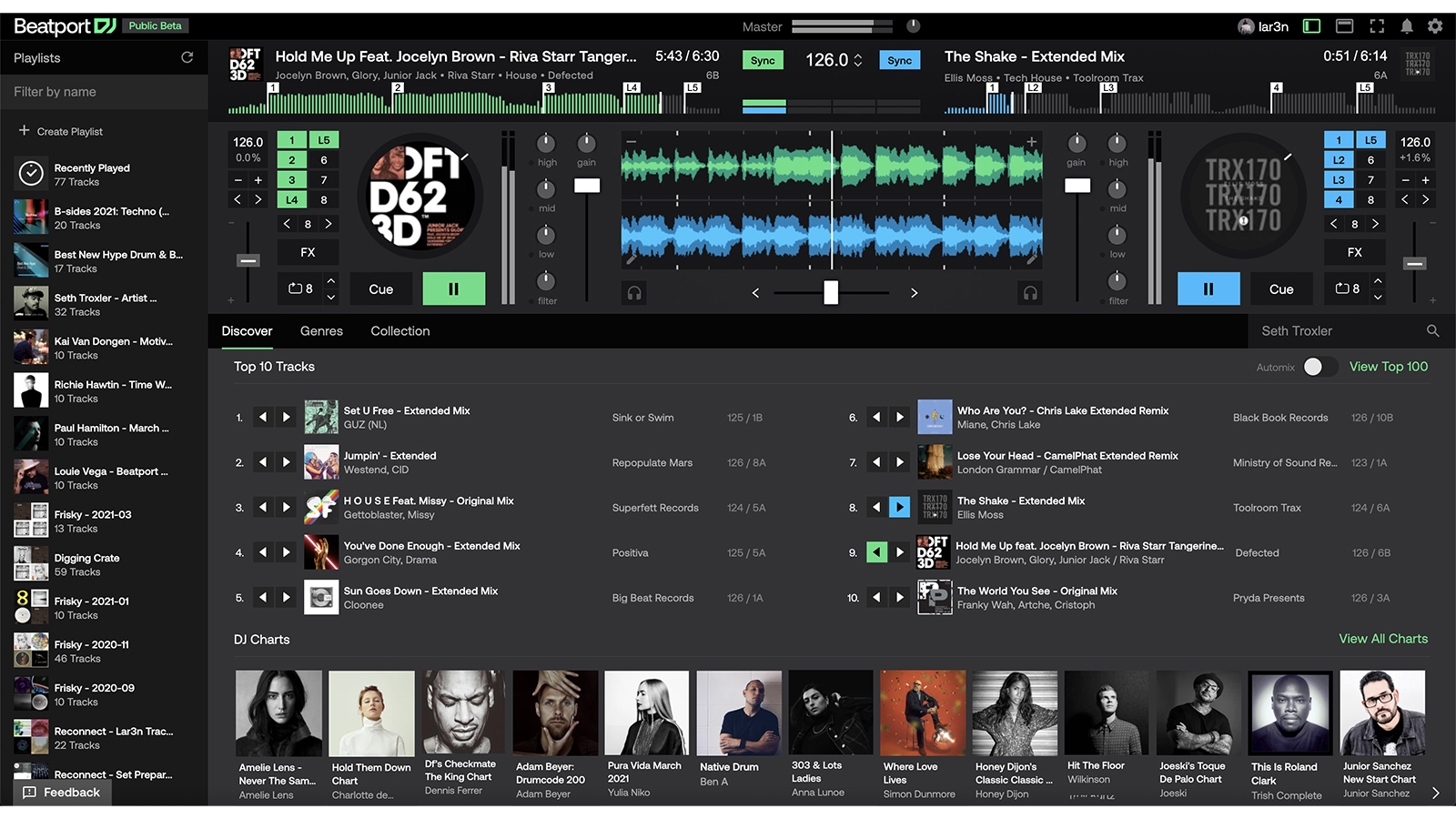
7. Beatport DJ/Beatsource DJ
Our expert review:
Specifications
Reasons to buy
Reasons to avoid
Beatport DJ and Beatsource DJ are slightly different to the other applications in our guide. As opposed to being regular mixing applications, both are browser-based DJ tools that can be used as part of their respective company’s track streaming services.
Both Beatport and Beatsource offer users access to a large catalogue of streamable music to use in DJ sets. Both libraries offer integration into most major DJ applications, but they can also be used directly from a web browser via these surprisingly well equipped DJ tools.
Although Beatport and Beatsource are separate streaming services, both use identical underlying technology, hence why we’re lumping them together here. The key difference between the two comes down to their catalogue of tracks – speaking very broadly, Beatport is better for club DJs and Beatsource more gear toward event or pop DJs.
Their browser-based DJ apps are identical. Both feature two decks with EQs, a filter, hot cues, a looper and XY effect pad. They’re MIDI equipped too, so you can even hook up a controller. The main appeal, however, is the ability to quickly grab tracks directly from the libraries’ playlists and charts to test out the latest tracks.
Both DJ applications are free to use, however unless you subscribe you’ll only be able to access 2-minute previews of any song.
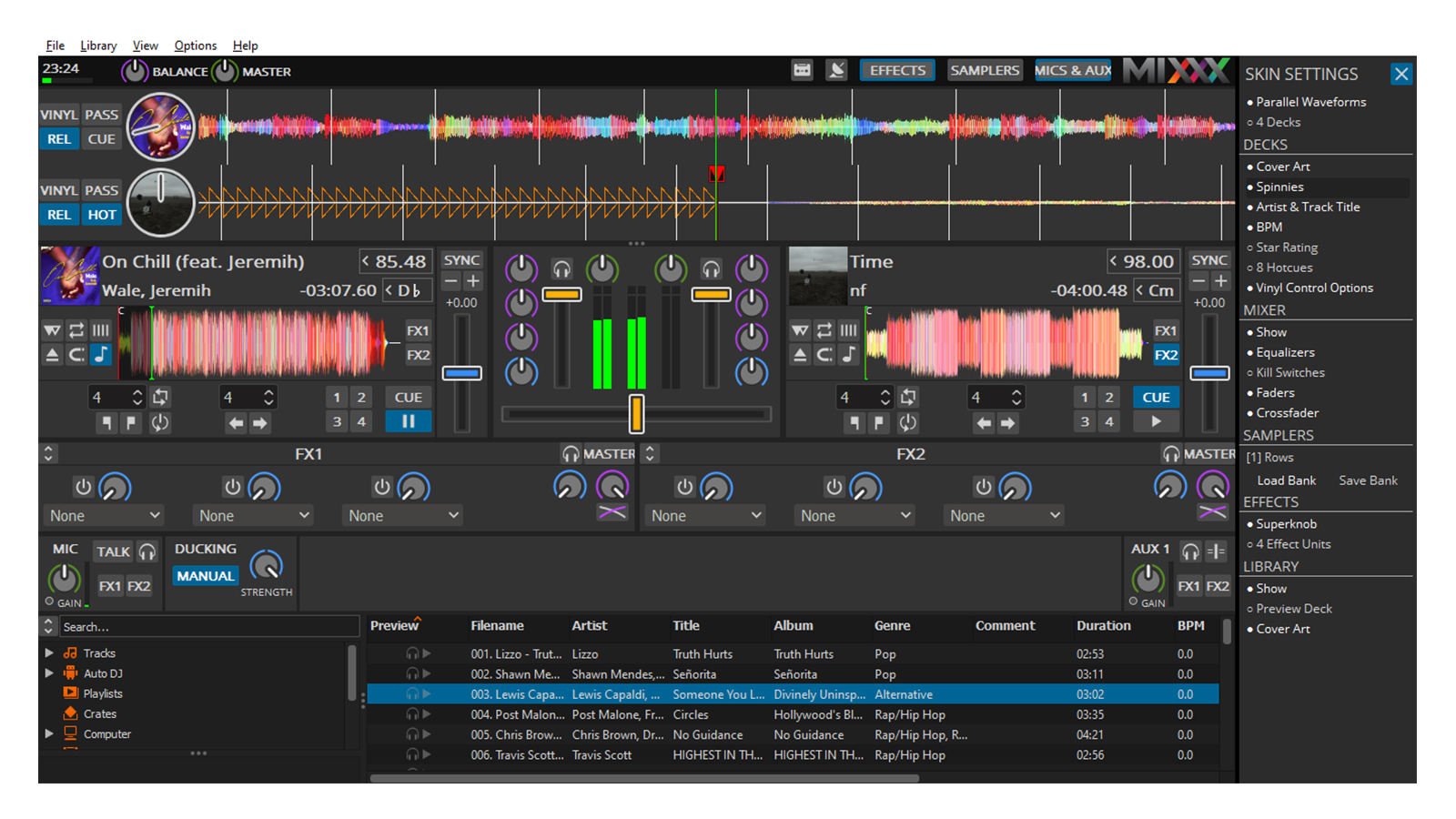
8. Mixxx
Our expert review:
Specifications
Reasons to buy
Reasons to avoid
Mixxx is a free and open-source music making application: not only can you download it for nothing, but the more adventurous can also delve into the code and adapt its feature set.
Mixxx has been around for some time and in 2024 it’s a mature piece of DJ software equipped with all the core tools you need to get mixing. These include control over four decks, EQs and effects, loops, hot cues and control over a track’s pitch and key.
Arguably most handy is its open controller integration – a large number of devices already have pre-existing mappings, and the setup is entirely open, meaning you can use any controller however you see fit. What’s more, Mixxx comes with DVS capabilities included, meaning it’s a great option if you want to try out digital vinyl/timecode control without having to invest upfront.
Due to its community-powered nature, Mixxx doesn’t keep up with the big name applications when it comes to flashy new features. That’s not to say it’s not regularly evolving though. Recent updates have added new methods to mark track sections as well as improved key detection. It has stem mixing capabilities – based on the older Native Instruments format – but no AI-powered stem separation.
Best DJ software: Buying advice

The core elements of most DJ software tends to be pretty similar – aside from Ableton Live, as discussed above. All offer at least two (and usually four or more) decks, plus EQs, filters, effects, some form of sampling and looping, and likely much more besides. Points of difference often come down to more advanced features – such as lighting or visual control, or fancy new algorithmic processes.
Stem Separation
MusicRadar's got your back
Stem separation is the feature-of-the-moment in the DJ realm, but what exactly does it do? Essentially, these features use AI-powered tech to separate mixed audio files down into their requisite parts, meaning that the DJ can then play, mix and effect these independently.
The way each piece of software handles this varies slightly, although it’s common to find tracks are split into four elements – drums, bass, vocals and ‘other’. The quality of separation also varies from application to application, but on the whole this technology has come on in leaps and bounds in recent years, quickly going from a quirky, if unreliable, novelty, to something truly useful.
How important these features are to you will depend on the type of DJ you are and the style of music you play. Some people will find it a complete gamechanger, others will likely never even touch them.
Library management
The secret to being a good DJ is admin. Having your library of tracks correctly named, labelled and tagged, with any cue points assigned ahead of time, will make any DJ set far easier.
All DJ software will feature some form of library for organising and browsing your tracks, but not all are created equal. Some allow you to transfer data to other machines, such as a tablet or CDJ, others might let you back-up data to the cloud.
Many applications also let you integrate or import music from elsewhere, such as importing playlists from Apple Music or Spotify or integrating streaming services.
Controllers
It’s perfectly possible to DJ without a MIDI controller, using your mouse and keyboard shortcuts to play and sync tracks, change levels and browse music. This is neither a very precise nor fun way to interact with DJ software though. Without some level of hands-on control it can be difficult to achieve things like rapid EQ changes, quick cuts, or nudging tracks into sync.
DJ controllers are available in a whole host of shapes and sizes, and the model that suits you best will come down to DJ style, budget and space. However, your choice of controller and DJ software is inherently linked. Some devices are designed to work specifically with one application, others can be used effectively across multiple apps.
There are two ways to approach this – your choice of DJ software could be guided by having a specific controller you already own, or like the look of, or you could experiment with several applications and then choose a controller based on which application you get on best with.
What is DVS?
DVS stands for ‘digital vinyl system’, but it’s used as a bit of a catch-all term to refer to any system that allows a user to control DJ software with timecode CDs or vinyl records. Essentially, this lets you hook a traditional set of turntables or CDJs up to your DJ software and control them with the use of special CDs or records.
These sorts of setup are of particular interest to ‘scratch’ DJs and turntablists, who rely on the authentic feel and behaviour of vinyl to finesse their skills. There are other reasons to consider this sort of setup though – for one, it allows you to ‘digitise’ an existing DJ setup, should you wish to make the move from all vinyl or CDJ mixing to the convenience of software.
A note on DJ software subscriptions
Subscription models are popping up with increasing frequency across the music software realm, but they’re especially prevalent within the DJ sector.
DJ subscriptions come in two forms. First, there are software applications themselves. As you’ll see in this guide, an increasing number of mixing applications either offer or require a subscription in order to access their full feature sets.
If we’re being honest, these subscriptions often feel designed to benefit the companies selling them more than the users. Yes, you’ll likely get something along the lines of cloud storage or live service features in exchange for your monthly payment, but it’s hard to shake the feeling that they’re often a cynical way to regularly monetise something that many pro users rely on for their regular gigs.
Fortunately, subscriptions are still avoidable, for home or semi-pro users in particular. First and foremost, you could opt to use an application that offers a single licence purchase – or even one that’s entirely free. Alternatively, some applications, such as rekordbox, let you bypass a subscription – at least for some ‘pro’ features – by connecting a branded controller.
The second form of subscription is one that offers access to a streamable library of music. These are essentially the same as something like a Spotify or Apple Music subscription, but integrated into your DJ software. The most notable DJ streaming services out there right now come from Beatport, Beatsource and SoundCloud. Tidal can also integrate into some DJ applications, albeit with some legal restrictions. We’ve delved into all these options in more depth in our guide to DJ streaming services.
Find out more about how we test music gear and services at MusicRadar.
Related buyer's guides
- Explore the best studio headphones for music making
- Expand your setup with the best DJ laptops
- Our pick of the best DJ headphones available today
- Take a look at the best beginner DJ mixers
- Best beginner DJ controllers: affordable hardware for budding mix masters
- Best DJ speakers for home and the DJ booth
- Our pick of the best gifts for DJs
Want all the hottest music and gear news, reviews, deals, features and more, direct to your inbox? Sign up here.
I'm the Managing Editor of Music Technology at MusicRadar and former Editor-in-Chief of Future Music, Computer Music and Electronic Musician. I've been messing around with music tech in various forms for over two decades. I've also spent the last 10 years forgetting how to play guitar. Find me in the chillout room at raves complaining that it's past my bedtime.